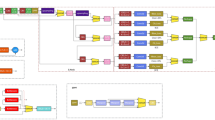Abstract
Surveillance systems are commonly used by command centers to monitor and assess seismic damage inside buildings, such as schools, shopping malls, office buildings and skyscrapers. It is expected that checking camera images manually on monitors can be a very time-consuming and inefficient process, especially for a large surveillance system. One of the alternative ways is to first deploy sensors to monitor objects inside buildings, such as tables, cabinets, bookcases and so on, and, after fusing sensor data, to assess damage. However, deploying sensors can be impractical and costly when there are too many objects needed to be monitored. In this paper, we present IDEAS, an image-based disaster damage assessment system, to evaluate seismic damage inside buildings. IDEAS first compares images taken inside a building before and after an earthquake, it then maps the damage to a Mercalli intensity scale. In order to investigate the effectiveness and accuracy of IDEAS, we collect over forty pairs of closed-circuit television (CCTV) images from Youtube website. Each pair of images represents a real scenario of an earthquake inside a building. Our results show that IDEAS performs better than existing methods and can achieve an average accuracy of 97.6 % in mapping Mercalli intensity scale.










Similar content being viewed by others
References
Chu ET-H (2014) The list of videos. https://sites.google.com/site/edwardchutw/video_links.txt, Accessed 5 March 2015
Conde C, Moctezuma D, MartíN De Diego I, Cabello E (2013) Hogg: Gabor and hog-based human detection for surveillance in non-controlled environments. Neurocomput 100:19–30
Dalal N, Triggs B, Schmid C (2006) Human detection using oriented histograms of flow and appearance. In: Proceedings of the 9th European conference on computer vision - Volume Part II, ECCV’06, pp 428–441
Ergin T, Erberik MA, Kurc O, Birgonul T, Balta S, Ergen E (2012) Post-disaster sensor-based condition assessment of buildings to develop evacuation strategies. In: The 14th international conference on computing in civil and building engineering (14th ICCCBE)
Gunawan LT, Fitrianie S, Yang Z, Brinkman WP, Neerincx M (2012) Travelthrough: a participatory-based guidance system for traveling through disaster areas. In: CHI ’12 extended abstracts on human factors in computing systems, pp 241–250
Huang L, Li Z (2010) Feature-based image registration using the shape context. Int. J. Remote Sens. 31(8):2169–2177
Huang L, Li Z, Zhang R (2010) Sar and optical images registration using shape context. In: 2010 IEEE international geoscience and remote sensing symposium (IGARSS), pp 1007–1010
Kuno Y, Watanabe T, Shimosakoda Y, Nakagawa S (1996) Automated detection of human for visual surveillance system.. In: Proceedings of the 13th international conference on pattern recognition, vol 3, pp 865–869
Liu J, Shih CS, Chu EH (2013) Cyberphysical elements of disaster-prepared smart environments. Computer 46(2):69–75
Lowe DG (2004) Distinctive image features from scale-invariant keypoints. Int J Comput Vis 60(2):91–110
Matlab (2014). http://www.mathworks.com, Accessed 5 March 2015
Naidu V (2014) Multi modal image segmentation. http://www.mathworks.com/matlabcentral/fileexchange/28418-multi-modal-image-segmentation, Accessed 5 March 2015
Natural Resources Canada (2014) The Modified Mercalli (MM) Intensity Scale. http://www.earthquakescanada.nrcan.gc.ca/info-gen/scales-echelles/mercalli-eng.php, Accessed 5 March 2015
OASIS Emergency Management Technical Committee (2010) Cap: Common alert protocol, v1.2. http://docs.oasis-open.org/emergency/cap/v1.2/CAP-v1.2-os.html, Accessed 5 March 2015
O’Callaghan R, Bull D (2005) Combined morphological-spectral unsupervised image segmentation. IEEE Trans Image Process. 14(1):49–62
Soille P (2014a) Morphological image analysis: Principles and applications, pp 170–171
Soille P (2014b) Morphological image analysis: Principles and applications, pp 173–174
van den Boomgaard R, van Balen R (1992) Methods for fast morphological image transforms using bitmapped binary images. CVGIP: Graph Model Image Process 54 (3):252–258
Vural U, Akgul YS (2011) A parallel non-linear surveillance video synopsis system with operator eye-gaze input. In: Weiyao, L (ed) Video Surveillance, InTech, pp 335–357
Wikipedia (2013) Mercalli intensity scale. http://en.wikipedia.org/wiki/Mercalli_intensity_scale, Accessed 5 March 2015
Yonglin S, Lixin W, Zhi W (2010) Identification of inclined buildings from aerial lidar data for disaster management. In: The 18th international conference on geoinformatics, pp 1–5
Youtube (2014) https://www.youtube.com/, Accessed 5 March 2015
Zhang S, Jiang J, Cao S (2012) Relative shape context based on multiscale edge features for disaster remote sensing image registration.. In: The third international conference on intelligent control and information processing (ICICIP), pp 605–609
Acknowledgments
The work was supported by Academia Sinica Project AS-101-TP2-A01.
Author information
Authors and Affiliations
Corresponding author
Rights and permissions
About this article
Cite this article
Chu, E.TH., Wu, CC. An image-based seismic damage assessment system. Multimed Tools Appl 75, 1721–1743 (2016). https://doi.org/10.1007/s11042-015-2602-9
Received:
Revised:
Accepted:
Published:
Issue Date:
DOI: https://doi.org/10.1007/s11042-015-2602-9




